Menus
- Duel of the 800 travel enduros
- Both engines are potent, never overwhelmed and easy to dose
- Drilling is based on the 675 Daytona engine
- BMW is the fun bike among the mid-range motorhomes
- The BMW F 800 GS is unbeatable off-road
- Technical data and measured values
- Performance measurement
- Equipment in detail
- MOTORCYCLE scoring
- Conclusion
- Price comparison for the BMW F 800 GS and Triumph Tiger 800 XCX
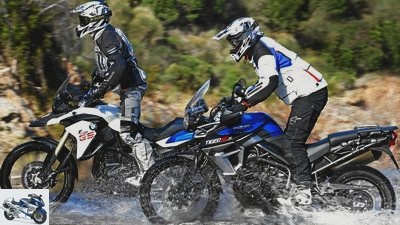
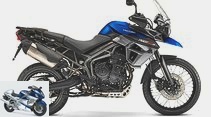
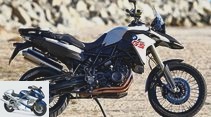
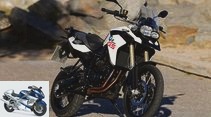
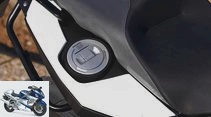
37 photos
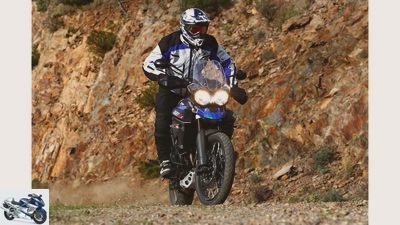
1/37
Triumph Tiger 800 XCx.
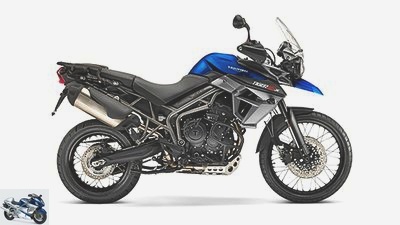
triumph
2/37
Not a bargain, but a two plus proves: The Triumph Tiger 800 XCx offers a lot of technology for the money.
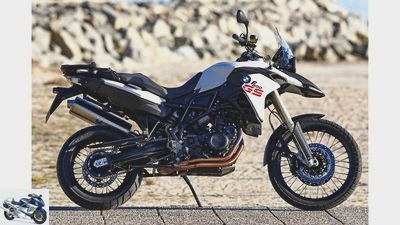
3/37
BMW F 800 GS.
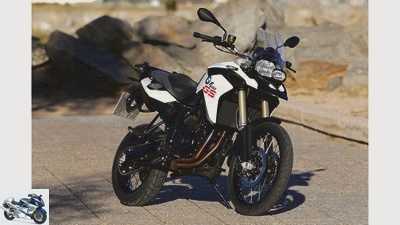
4/37
BMW F 800 GS.
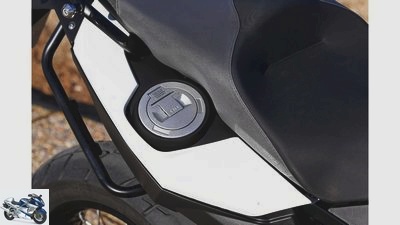
5/37
BMW F 800 GS.
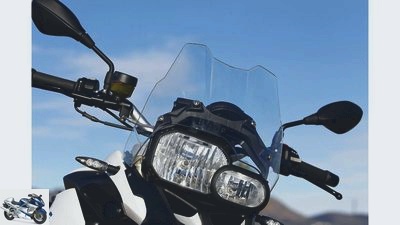
6/37
BMW F 800 GS.
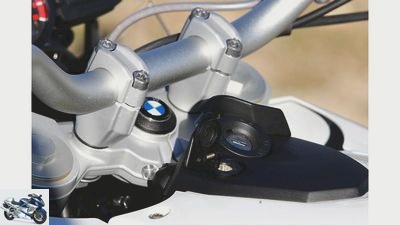
7/37
BMW F 800 GS.
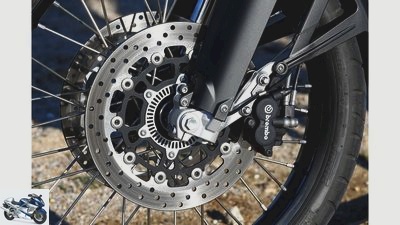
8/37
BMW F 800 GS.
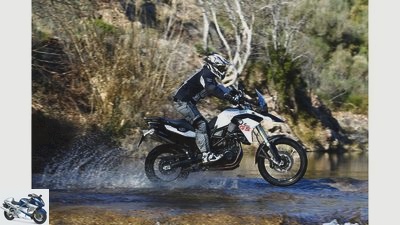
9/37
BMW F 800 GS.
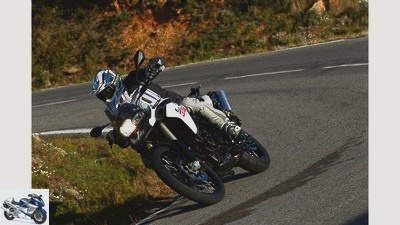
10/37
BMW F 800 GS.
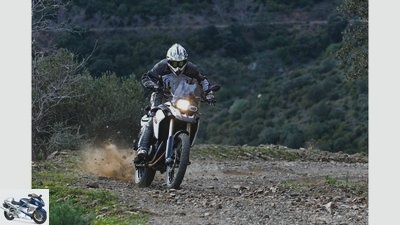
11/37
BMW F 800 GS.
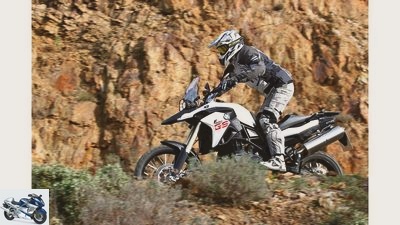
12/37
BMW F 800 GS.
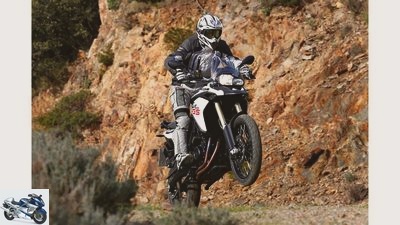
13/37
BMW F 800 GS.
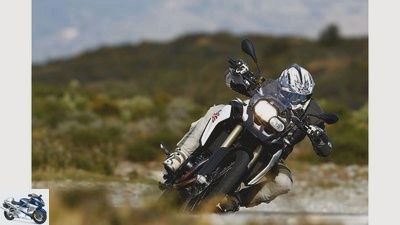
14/37
BMW F 800 GS.
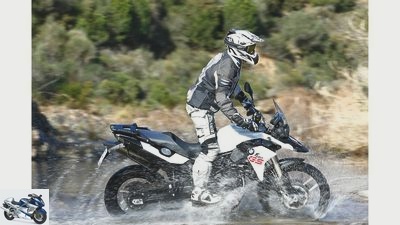
15/37
BMW F 800 GS.
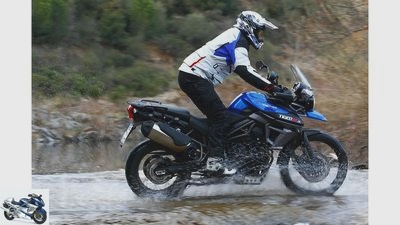
16/37
Triumph Tiger 800 XCx.
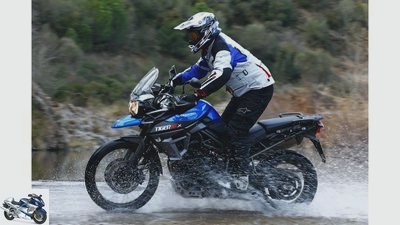
17/37
Triumph Tiger 800 XCx.
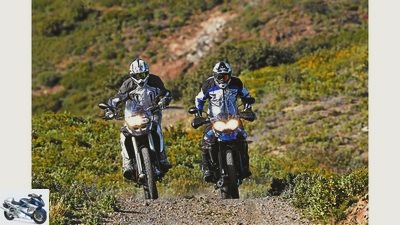
18/37
BMW F 800 GS and Triumph Tiger 800 XCx.
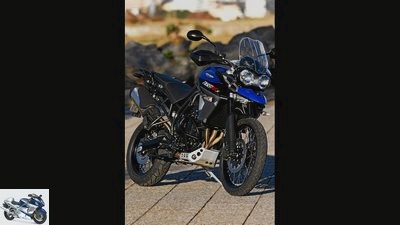
19/37
Appearances are deceptive: the off-road appearance is deceptive. At its core, the Triumph Tiger 800 XCx is a touring motorcycle. A very good one.
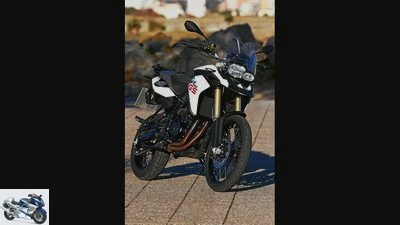
20/37
Tall and narrow: the silhouette already documents the orientation of the BMW F 800 GS – fun, off-road, touring. In this order.
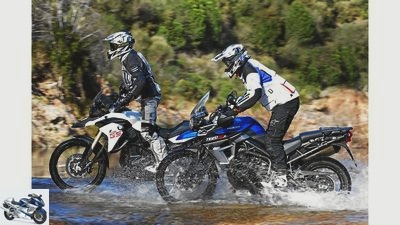
21/37
BMW F 800 GS and Triumph Tiger 800 XCx in comparison test.
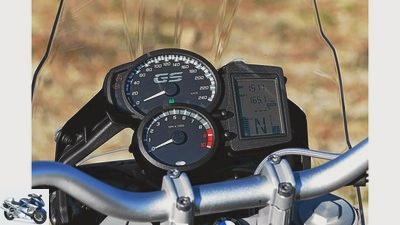
22/37
BMW F 800 GS: Round, angular, good: what you want to know can be seen. You don’t need more.
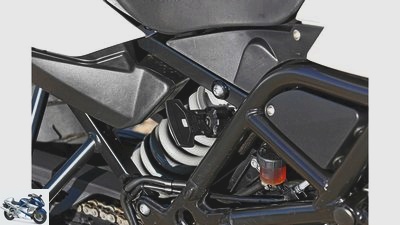
23/37
BMW F 800 GS: The angular in the round: smart attachment aid on the handwheel for pre-tensioning.
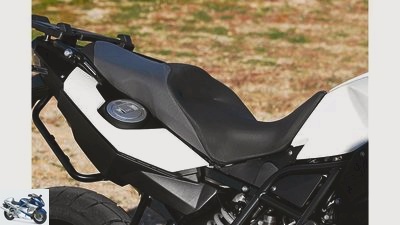
24/37
BMW F 800 GS: Why not always like this? Great seating comfort thanks to the BMW retrofit seat.
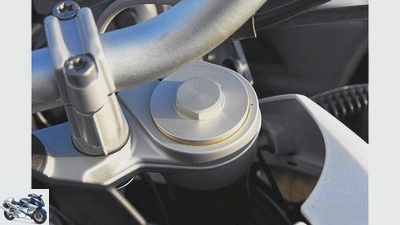
Mayer
25/37
BMW F 800 GS: That’s how it is and how it stays: non-adjustable fork.
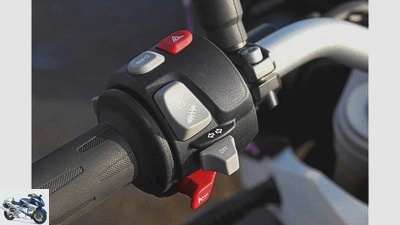
Mayer
26/37
BMW F 800 GS: All right: many functions, little stress – easy-to-understand switches.
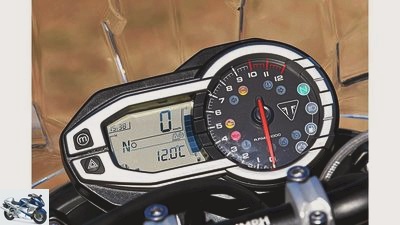
27/37
Triumph Tiger 800 XCx: Who can see through? Orderly look, but confusing menu navigation.
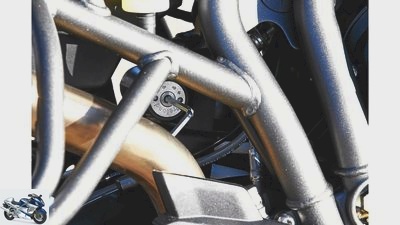
28/37
Triumph Tiger 800 XCx: Difficult: preloading with on-board tools.
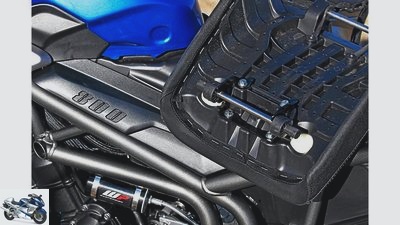
29/37
Triumph Tiger 800 XCx: Jerk, beck: seat height adjustment by simply hanging two rods.
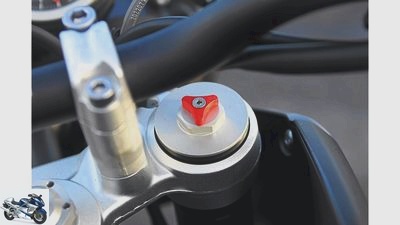
Mayer
30/37
Triumph Tiger 800 XCx: Well done: toolless adjustment of the damping on the WP fork.
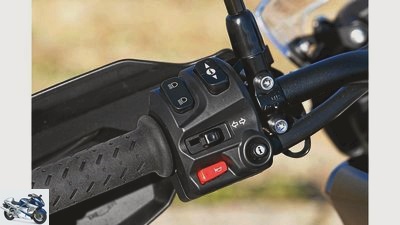
31/37
Triumph Tiger 800 XCx: You have to get used to it: Modern button variety.
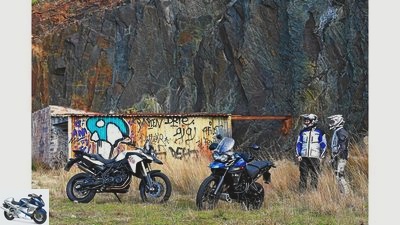
32/37
800 cm³ – a cubic capacity which actually hits the golden mean that is so often invoked.
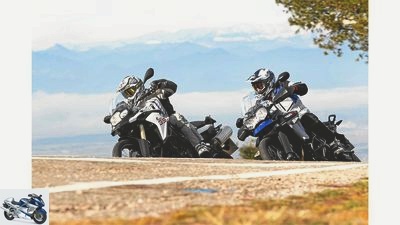
33/37
On line. Whether nimble on the inside line like the BMW F 800 GS or sovereign on the outside lane like the Triumph Tiger 800 XCx – cornering fun is also a question of character.
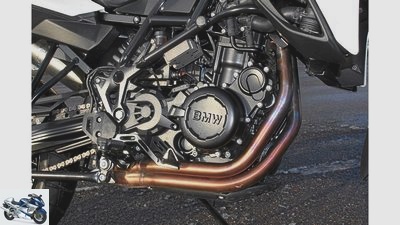
Mayer
34/37
BMW F 800 GS – uncomplicated: The lively and powerful co-driver essentially determines the character of the 800 GS.
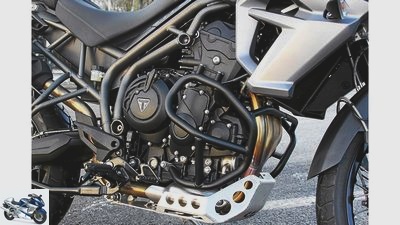
Mayer
35/37
Triumph Tiger 800 XCx – Velvet and silk: With the new engine set-up, the already well-behaved treble is even smoother. An experience.
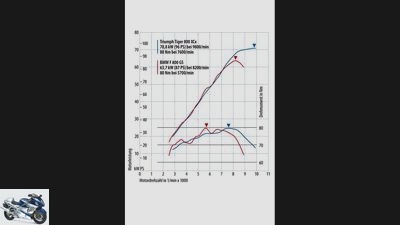
36/37
The BMW F 800 GS looks more excited on paper than it does on the road.
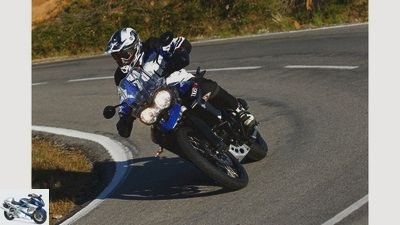
37/37
Triumph Tiger 800 XCx.
BMW F 800 GS and Triumph Tiger 800 XCx in comparison test
Duel of the 800 travel enduros
Travel enduros shine in city, country and sometimes in the river. Four years ago, the Triumph Tiger 800 XC fired up the top of the delicately cut middle-class establishment, the BMW F 800 GS. Now the British have followed suit with the new Triumph Tiger 800 XCx.
You can feel how the duo BMW F 800 GS and Triumph Tiger 800 XCx is watching each other suspiciously out of the corner of their eyes, carefully sniffing the scent mark of the other person, confidently throwing themselves into their chests. Just don’t send a signal of weakness. Not at the first meeting after almost exactly four years. Because since the fight for the lead in the pack of middle class travel enduros in issue 9/2011, the two had avoided each other in all MOTORRAD comparison tests carried out since then. The dispute at the time was violent, the result close. The new release was triumphant by a single point Tiger 800 XC bitten the F 800 GS from the leadership position. But not from the best place on the food bowl. To this day, the Bavarian, which has only been slightly modified since its appearance in 2008, holds its position as the best-selling 800 travel enduro with top ten positions in the annual approval charts. The little tiger ranks almost 20 places behind. So far.
Buy complete article
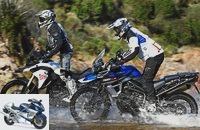
BMW F 800 GS and Triumph Tiger 800 XCx in comparison test
Duel of the 800 travel enduros
Seat of the Triumph Tiger 800 XCx more touristy than sporty
No wonder, the little Triumph Tiger 800 XCx hisses confidently with its throaty, hoarse sounding three-cylinder, thus creating a contrast to the sonorous, boxer-like sound of the twin of the GS. The first try-on is as different as the acoustics. The BMW F 800 GS sits very compactly. The knee grip, the distance from the seat to the handlebars or the fittings, everything looks slim, short and filigree, exudes a sporting spirit. Triumph is more relaxed. The tank is a bit wider, the handles and levers appear bulkier, and the distance between the seat nose and the handlebars is a bit larger. Overall, the arrangement conveys a sense of space, has a more touristy than sporty feel. Also because the newly shaped handlebars now stretch further towards the pilot, stretching it less over the tank than the much criticized, less cranked predecessor version.
The staff has long since made themselves comfortable on the duo. Advantage of the Triumph Tiger 800 XCx: At 87 centimeters, the seat height is slightly lower than that of the BMW F 800 GS (89 centimeters) and can be lowered again by 20 millimeters in no time without tools. The Triumph’s standard seat cushion was also upholstered straight away. The BMW can only parry with a comfort seat (surcharge 100 euros). The seating on the test GS nestles better against the popometer than the comparably hard and narrow standard seat.
Both engines are potent, never overwhelmed and easy to dose
The small fields of the Empordà, the north-easternmost tip of Spain, spread out contemplatively. Just a few kilometers further, the foothills of the Pyrenees push themselves over the plain, threatening with their white, sugared, wintry slopes. No reason to shiver. Here, just above sea level, cacti proliferate on the southern slopes, temperatures rarely drop below double-digit values. Even the asphalt shows itself in the spring mood, winds in a comfortable temperature over the hills that are only a few hundred meters high behind the coastal strip. It’s amazing how quickly you can get yourself back in the mood, develop a feeling for grip, inclination and choice of lines. Probably also because the duo BMW F 800 GS and Triumph Tiger 800 XCx make cornering as easy as possible. Potent, but never overwhelming, easy to dose and yet with strong pressure, the two 800 engines push forward. A displacement size that actually seems to hit the golden mean that is so often invoked.
And just as directly as it sits on the BMW F 800 GS, the co-running machine with 360-degree ignition offset also pushes off without make-up. From 2500 tours it bites and shakes the curve twist loosely and lively from mid-speed. The fact that the twin does not even turn 9000 rpm is hardly noticeable in the convincing appearance. And only after the initial euphoria will the Bayern courier notice that the vibration-damping auxiliary connecting rod of the two-cylinder cannot prevent the rough tingling after 6000 tours. Nonetheless: With this unvarnished style, the Twin, manufactured by Rotax in Austria, continues to cast its spell over its staff, combining efficiency with character.
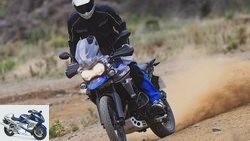
Enduro
Driving report Triumph Tiger 800 XR, XC, XRx and XCX
X for offense …
read more
All articles about the Triumph Tiger 800 XC
Drilling is based on the 675 Daytona engine
However, the Triumph Tiger 800 XCx is responsible for perfection. As if the triplet, based on the 675 Daytona engine, had not already been knighted in terms of running culture when it was presented in 2011, the British are adding the throttle valves (ride-by-wire), which are now operated by servomotors. As if lined with velvet, the three-cylinder now responds even more gently, can be dosed even more finely and turns up even more smoothly than the previous model. So sensitive and well-behaved that the propellant needs all its strength to convince the chauffeur, enraptured by this gentleness, of the true potential of the triple. After all, with a measured 96 hp, nine horses more pull the chain than with the BMW F 800 GS engine. And like a straightening iron, the electronics bring the already exemplary torque curve back into shape.
Compared to the previous model, five Newton meters more torque is available over long stretches of the engine speed range than before. Only very critical minds will miss the kick with this uniform increase in torque, with which, for example, the 675 Street Triple still excites in the top third of the speed. The fact that in the well-kept nursery of the Triumph Tiger 800 XCx the four differently aggressively appealing engine mappings (Rain, Road, Sport, Offroad) almost border on overkill and the well-behaved trident is still child’s play to dose even in the most aggressive level, rounds off the grandiose appearance completely off. Especially since the traction control, which is also new, inconspicuously slows down happy exuberance. They have not yet been able to definitively prove that the bits and bytes – as promised by Triumph – also ensure moderate fuel consumption. Even the well-known economical BMW F 800 GS consumed about four tenths more than usual with 4.6 liters on the moderately driven test lap. With a total of 5.0 liters, the Tiger was a tad closer to the Bavarian than before.
BMW is the fun bike among the mid-range motorhomes
Although the BMW F 800 GS in a duel with the Triumph Tiger 800 XCx is not defeated that quickly anyway. The closer the curves wind around the rocky ridges, the more the GS regains its self-confidence. It swiftly wiggles through alternating curves, maintains its lane, conveys clear feedback and is, so to speak, the fun bike among mid-range motorhomes. Even the simple ESA (Electronic Suspension Adjustment, 305 euros), which only adjusts the rebound damping of the shock absorber in the 800 series, cuts a fine figure and covers a huge range with the three different settings (sport, normal, comfort). Especially since the – non-adjustable – fork works sensitively and the GS helps to deal with bumpy slopes with ease.
But it is precisely on this surface that the new Triumph Tiger 800 XCx has noticeably caught up. While the Briton hopped from pothole to pothole until now rather overdamped, the spring elements from WP Suspension – the Austrian manufacturer belongs to the KTM group – are much more sensitive. The fully adjustable fork and the shock absorber with adjustable shock absorption handle asphalt interference much more sensitively than before. Above all, the front, which was previously too damped, now appears more liberated, allowing the steering to work more accurately and with greater agility. What still has to be put into perspective in the triumph. Because when it comes to handling, the English rider cannot hold a candle to the BMW F 800 GS – despite the shorter wheelbase, despite the steeper steering angle and despite shorter caster.
Ultimately, the perceived heaviness is certainly not based on the weight difference between the 232 kilo Triumph Tiger 800 XCx and the BMW F 800 GS (222 kg), but rather on their distribution. Because with the GS just 46 percent of the total weight is on the front, with the Triumph at least 50 percent of the mass is on the front. No effect without side effects: on smooth asphalt, the weighty bow literally bites into the ground, giving the impression that instead of the narrow 21-inch asphalt cutter, a wide 19- or 17-inch tire has taken the lead. A feeling that explains why the XCx feels more touring than enduristic on the road, despite all its off-road regalia. Incidentally, the Triumph could make better use of the theoretical advantage of the front-heavy weight distribution in pillion mode. In this regard, the BMW not only sets the bar with a well-designed seat cushion, but also places the passenger closer to the pilot and thus noticeably more neutral on the vehicle.
The BMW F 800 GS is unbeatable off-road
Back to the off-road regalia. Word got around among globetrotters long ago what a brilliant figure the 800-series BMW makes off the road. The baby GS is likely to have long since replaced its big 1200 sister in terms of numbers in the great deserts of this earth. And even on the small gravel roads of northern Spain, the 800s fear nothing or anyone. Pottel, pottel, pottel, on the first ascent of gravel, the traction control slows down the desert flea. Oops, forget off-road mode. A click on the handlebar switch allows ABS and traction control more slip. It works now. A drift can be initiated playfully with the wonderfully adjustable power of the twin, the off-road ABS expands the limits of the anti-lock device on the front and rear wheel, generously and yet foolproof. Anyone who still thinks they are superior to this regulation with deactivated ABS when it is voted on, has – at least – a stable self-confidence. And it shouldn’t be said only to him: Off-road, the BMW F 800 GS won’t even be able to compete with any multi-cylinder enduro. Guaranteed none.
And certainly not the Triumph Tiger 800 XCx. Because despite the adventure outfit described, the enthusiasm for the rough with the Triumph is limited. The fact that the Tiger’s off-road mode, which can only be activated via a button on the display, switches off the ABS on the rear wheel and pushes the blocking limit of the front wheel beyond a fee, doesn’t make matters any better. Compared to the nimble BMW F 800 GS, the English girl pats slowly along the paths, pushes the front wheel to the outside of the bend with the front wheel even in slightly sandy terrain, appears heavy and unwieldy. The Briton can hardly be persuaded to do more than a detour on moderate gravel roads.
And return the favor for the indulgence later on every meter of asphalt. The larger screen provides noticeably more effective wind protection than before, the self-resetting turn signals for more passive safety and the cruise control, which is standard in the Triumph Tiger 800 XCx, for additional luxury. All things that together with the extremely successful fine-tuning of the engine management and the readjusted suspension significantly enhance the Triumph and emphasize its tourist strengths even more. And that’s why sports fans and off-road enthusiasts alike will continue to generously treat the honest and agile BMW F 800 GS to the fun.
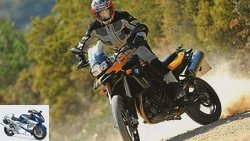
Used purchase
Second-hand advice BMW F 800 GS
Off to the terrain
read more
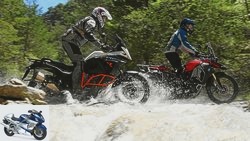
Enduro
KTM 1190 Adventure R and BMW F 800 GS Adventure put to the test
What good are the enduros off-road and on the road?
read more
Technical data and measured values
Appearances are deceptive: the off-road appearance is deceptive. At its core, the Triumph Tiger 800 XCx is a touring motorcycle. A very good one.
engine
| BMW F 800 GS | Triumph Tiger 800 XCx | |
| design type | Two-cylinder four-stroke- In-line engine |
Three-cylinder four-stroke- In-line engine |
| injection | 2 x Ø 46 mm | 3 x Ø 44 mm |
| coupling | Multi-panes- Oil bath clutch |
Multi-panes- Oil bath clutch |
| coupling | 82.0 x 75.6 mm | 74.0 x 61.9 mm |
| Displacement | 798 cc | 799 cc |
| compression | 12.0: 1 | 11.3: 1 |
| power | 62.5 kW (85 PS) at 7500 rpm |
70.0 kW (95 PS) at 9250 rpm |
| Torque | 83 Nm at 5750 rpm | 79 Nm at 7850 rpm |
landing gear
| BMW F 800 GS | Triumph Tiger 800 XCx | |
| frame | Tubular space frame from steel |
Bridge frame made of tubular steel |
| fork | Upside-down fork, Ø 45 mm |
Upside-down fork, Ø 43 mm |
| Brakes front / rear | Ø 300/265 mm | Ø 308/255 mm |
| Assistance systems | ABS, traction control | ABS, traction control |
| bikes | 2.15 x 21; 4.25 x 17 | 2.15 x 21; 4.25 x 17 |
| tires | 90/90 21; 150/70 R 17 | 90/90 21; 150/70 R 17 |
| Tires | Pirelli Scorpion Trail hi. “G” |
Bridgestone BW 501 “G” / BW 502 “G” |
measurements and weight
| BMW F 800 GS | Triumph Tiger 800 XCx | |
| wheelbase | 1578 mm | 1545 mm |
| Steering head angle | 64.0 degrees | 65.7 degrees |
| trailing | 117 mm | 95 mm |
| Front / rear suspension travel | 230/215 mm | 220/215 mm |
| Seat height¹ | 890 mm | 850-870 mm |
| Weight with a full tank¹ | 222 kg | 232 kg |
| Payload¹ | 222 kg | 206 kg |
| Tank capacity | 16.0 liters | 19.0 liters |
| Service intervals | 10,000 km | 10,000 km |
| price | 11,000 euros | 11,790 euros |
| Price test motorcycle | 12,275 euros² | 11,790 euros |
| Additional costs | 385 euros | 350 Euro |
MOTORCYCLE readings
| BMW F 800 GS | Triumph Tiger 800 XCx | |
| Top speed | 200 (204 *) km / h | 204 (210 *) km / h |
| acceleration | ||
| 0-100 km / h | 4.0 sec | 4.0 sec |
| 0-140 km / h | 7.1 sec | 7.0 sec |
| Draft | ||
| 60-100 km / h | 4.4 sec | 4.1 sec |
| 100-140 km / h | 5.2 sec | 5.1 sec |
| 140-180 km / h | 9.2 sec | 8.5 sec |
| Consumption country road / 100 km | 4.6 liters | 5.0 liters |
| Reach country road | 348 km | 380 km |
* Manufacturer information; 1 MOTORCYCLE measurements; ²incl. Dynamic package (610 euros), consisting of: ASC, ESA and off-road mode ABS / ASC; Comfort package (465 euros), consisting of: case holder, heated grips, on-board computer and main stand; LED indicators (100 euros) and comfort seat (100 euros).
Performance measurement
Performance measurement.
The BMW F 800 GS looks more excited on paper than on the road. Hardly anything of the wavy torque curve can be felt in practice, the lively character of the Bayern twin does not reflect a full load curve anyway.
Instead, the test stand impressively demonstrates the alignment of the triple of the Triumph Tiger 800 XCx. The homogeneous power curve and the even torque curve impressively show how easily the three-cylinder works. Not in the picture: Compared to the previous model, the revised Tiger engine delivers almost continuously 5 Nm more torque.
Power on the crankshaft. Measurements on the Dynojet roller test stand 250, corrected according to 95/1 / EG, maximum possible deviation ± 5%.
Equipment in detail
800 cm³ – a cubic capacity which actually hits the golden mean that is so often invoked.
Board computer
| BMW F 800 GS | triumph Tiger 800 XCx |
|
| Operation on-board computer | Handlebar² | Handlebars |
| Average / instantaneous consumption | Series / series | Series/- |
| Average speed / travel time | Series/- | Series / series |
| second trip odometer | series | series |
| Ambient / engine temperature display | Series / series | Series / series |
| Gear indicator | series | series |
| Fuel gauge / timer | Series (bars) / Series | Series (bars) / Series |
| Remaining range | – | series |
Engine / chassis
| BMW F 800 GS | Triumph Tiger 800 XCx | |
| Oil level check | Dipstick | Sight glass |
| electronically adjustable chassis | 305 euros¹ | – |
| different engine mappings | Series (two) ¹ | Series (four) |
ergonomics
| BMW F 800 GS | Triumph Tiger 800 XCx | |
| adjustable windshield | – | – |
| Touring windshield | 307 euros | 180 euros (adjustable) |
| Hand protection | 116 euros | series |
| adjustable seat height | – | two-stage |
| Comfort seat | 319 euros | vo./hi. 210/150 euros |
| adjustable brake / clutch lever | Series / series | Series / series |
Luggage
| BMW F 800 GS | Triumph Tiger 800 XCx | |
| Luggage hook | series | series |
| Case system including case holder | 763 euros | 790 euros |
| Capacity per case (l./r.) | 19-29 / 28-38 liters | 31/31 liters |
| Topcase including holder | 404 euros | 552 euros |
| Topcase capacity | 25-35 liters | 35 liters |
| Tank bag | 174 euros | 115 euros |
| One key system | 35 euros each | series |
| Luggage rack | 60 euro | series |
Furnishing
| BMW F 800 GS | Triumph Tiger 800 XCx | |
| Heated grips | 205 euros² | 225 euros |
| Cruise control | – | series |
| navigation system | 696 euros | – |
| Main stand | 140 euros² | series |
| Aluminum engine protection | 211 euros | series |
| Engine protection bar | 282 euros | series |
| Immobilizer | series | series |
| Headlight range adjustment | with tools | without tools |
| Board socket | series | series |
| Stainless steel exhaust system | series | series |
| Cross-spoke wheels | series | series |
security
| BMW F 800 GS | Triumph Tiger 800 XCx | |
| Hazard warning lights | series | series |
| SECTION | Series (can be switched off) | Series (can be switched off) |
| Traction control | 2-stage (can be switched off) | 2-stage (can be switched off) |
– = not available; ¹ included in the dynamic package (610 euros), consisting of: ASC, ESA and off-road mode ABS and ASC; ² included in the comfort package (465 euros), consisting of: case holder, heated grips, on-board computer and main stand.
MOTORCYCLE scoring
On line. Whether nimble on the inside line like the BMW F 800 GS or sovereign on the outside lane like the Triumph Tiger 800 XCx – cornering fun is also a question of character.
engine
| Maximum score |
BMW F 800 GS |
triumph Tiger 800 XCx |
|
| Draft | 40 | 20th | 23 |
| acceleration | 40 | 18th | 18th |
| Top speed * | 30th | 13 | 13 |
| Engine characteristics | 30th | 20th | 21st |
| Responsiveness | 20th | 13 | 16 |
| Load change | 20th | 12th | 15th |
| Smoothness | 20th | 11 | 15th |
| coupling | 10 | 8th | 7th |
| circuit | 20th | 13 | 15th |
| Gear ratio | 10 | 8th | 8th |
| Start | 10 | 9 | 9 |
| total | 250 | 145 | 160 |
No other chapter the Triumph Tiger 800 XCx can win as clearly as the engine rating. The revision of the engine management gives the already supple three-cylinder even more finesse. The lively twin of the BMW F 800 GS can present itself well, but is only moderately cultivated due to strong vibrations from 6000 rpm.
Winner engine: Triumph Tiger 800 XCx
landing gear
| Maximum score |
BMW F 800 GS |
triumph Tiger 800 XCx |
|
| Handiness | 40 | 30th | 27 |
| Stability in turns | 40 | 26th | 28 |
| Steering behavior | 40 | 25th | 27 |
| feedback | 10 | 6th | 5 |
| Inclined position | 20th | 18th | 15th |
| Straight-line stability | 20th | 13 | 15th |
| Suspension tuning in front | 20th | 11 | 12th |
| Chassis set-up at the rear | 20th | 13 | 14th |
| Adjustment options undercarriage | 10 | 5 | 5 |
| Suspension comfort | 10 | 8th | 7th |
| Driving behavior with a passenger | 20th | 13 | 12th |
| total | 250 | 168 | 167 |
Scarce box: The BMW F 800 GS emphasizes its sporty qualities with light-footed handling, a successful suspension set-up and great freedom of lean angle. The Triumph Tiger 800 XCx counters its tourist strengths such as stable straight-line stability and smooth cornering. However, it is precisely there that it has to come to terms with its limited freedom of inclination.
Chassis winner: BMW F 800 GS
everyday life
| Maximum score |
BMW F 800 GS |
triumph Tiger 800 XCx |
|
| Ergonomics driver | 40 | 33 | 31 |
| Ergonomics pillion | 20th | 15th | 14th |
| Windbreak | 20th | 9 | 12th |
| view | 20th | 12th | 13 |
| light | 20th | 14th | 16 |
| Furnishing | 30th | 21st | 28 |
| Handling / maintenance | 30th | 17th | 17th |
| Luggage storage | 10 | 4th | 4th |
| Payload | 10 | 10 | 8th |
| Range | 30th | 21st | 24 |
| processing | 20th | 13 | 14th |
| total | 250 | 169 | 181 |
With improved wind protection, At least in the tested XCx version, extensive equipment and a range of 380 kilometers, the Triumph Tiger 800 XCx gets the decisive points cushion. Nevertheless: The sporty BMW F 800 GS of all things counters with outstanding seating comfort for the driver and especially the pillion passenger.
Winner everyday life: Triumph Tiger 800 XCx
security
| Maximum score |
BMW F 800 GS |
triumph Tiger 800 XCx |
|
| Braking effect | 40 | 28 | 27 |
| Brake metering | 30th | 19th | 18th |
| Braking with a passenger / fading | 20th | 14th | 12th |
| Righting moment when braking | 10 | 10 | 10 |
| ABS function | 20th | 13 | 14th |
| Handlebar slapping | 20th | 16 | 16 |
| Ground clearance | 10 | 10 | 9 |
| total | 150 | 110 | 106 |
Only marginal differences separate the duo in terms of security. Ultimately, the slightly more powerful brakes decide in favor of the BMW F 800 GS. Very good with both: the minimal tendency to pitch when braking.
Safety winner: BMW F 800 GS
costs
| Maximum score |
BMW F 800 GS |
triumph Tiger 800 XCx |
|
| guarantee | 30th | 17th | 18th |
| Consumption (country road) | 30th | 21st | 19th |
| Inspection costs | 20th | 18th | 16 |
| Maintenance costs | 20th | 14th | 13 |
| total | 100 | 70 | 66 |
Despite a two-year extended warranty in the Triumph Tiger 800 XCx, the more economical BMW F 800 GS wins the race.
Winner costs: BMW F 800 GS
| Maximum score |
BMW F 800 GS |
triumph Tiger 800 XCx |
|
| Overall rating | 1000 | 662 | 680 |
| placement | 2. | 1. | |
| Price-performance note | 1.0 | 2.1 | 1.8 |
Price-performance winner: Triumph Tiger 800 XCx
Not a bargain, but a two plus proves: The Triumph Tiger 800 XCx offers a lot of technology for the money
* Evaluation basis: MOTORCYCLE measurement
Conclusion
In the duel with the BMW F 800 GS, the Triumph Tiger 800 XCx ultimately prevailed.
1. Triumph Tiger 800 XCx
With an impressively improved engine set-up and sensitive suspension, the Triumph Tiger 800 XCx puts the BMW F 800 GS in its place. And: The new Tiger is even more tourist-oriented than its predecessor.
2. BMW F 800 GS
Lively, lively, off-road suitable – with these qualities, the BMW F 800 GS may collect fewer points, but a lot of people. The Baby-GS covers the largest range of uses in the mid-range segment.
Price comparison for the BMW F 800 GS and Triumph Tiger 800 XCX
1000PS marketplace app
The two mid-range travel enduros are very popular on the used market.
Mid-range enduros are very popular due to their compact size and the BMW F 800 GS and Triumph Tiger 800 XCX are no exception. With travel enduros, they convince on the used market with good availability and fair prices. Here is an overview of used BMW F 800 GS and Triumph Tiger 800 XCX: used BMW F800GS and Triumph Tiger 800 XCX in Germany.
Related articles
-
Adventure enduros in comparison test
Jahn 44 photos markus-jahn.com 1/44 Triumph Tiger 800 XCA. markus-jahn.com 2/44 Honda CRF 1000 L Africa Twin. markus-jahn.com 3/44 Honda CRF 1000 L…
-
BMW K 1600 GT Sport and BMW R 1200 RT in comparison test
Bilski 37 pictures Bilski 1/37 The new strut of the RT could respond better, spring and dampen more finely. And there are top tourers with more …
-
BMW F 800 GS and Triumph Tiger 800 XC in comparison
Jahn 18th photos Jahn 1/18 Neither of them are averse to moderate off-road activities. Jahn 2/18 The picture is deceptive. The Triumph cannot outpace the…
-
BMW R 1200 RT and Triumph Trophy 1200 SE in comparison
comparison test: top tourers from BMW and Triumph BMW R 1200 RT and Triumph Trophy 1200 SE in comparison The plan, in three days mountains, sea and …
-
BMW, Kawasaki, Triumph and Yamaha Tourer in comparison test
Gargolov 31 pictures Gargolov 1/31 Tourer comparison test: Triumph Trophy SE, BMW R 1200 RT, BMW K 1600 GT, Yamaha FJR 1300 and Kawasaki 1400 GT. Gargolov …
-
Comparison test: KTM 990 SM T against Triumph Tiger 1050 SE
fact Funbike comparison test: KTM against Triumph The fun tourers KTM 990 SM T and Triumph Tiger 1050 SE Anyone who cares for Rabatz so early in the year has to …
-
24 pictures Triumph 1/24 Triumph Tiger 800: The three-cylinder engine generates 95 hp at 9300 rpm from 799 cubic meters. Triumph 2/24 Triumph Tiger 800 XC …
-
Driving report Triumph Tiger 800 XCx and XRx
triumph 31 photos triumph 1/31 triumph 2/31 triumph 3/31 triumph 4/31 triumph 5/31 triumph 6/31 triumph 7/31 triumph 8/31 triumph 9/31 triumph 10/31…
-
1000cc travel enduro bikes from Suzuki, Kawasaki and Triumph put to the test
fact 37 photos fact 1/37 fact 2/37 Suzuki V-Strom 1000: Exclusive: Suzi’s disc is height-adjustable and its inclination can be adjusted in no time at all…
-
Jahn 34 Pictures Jahn 1/34 Jahn 2/34 Lonely: The KTM is the only one of the Adventure Enduros to stay with chain drives. Light, but in need of care. Jahn 3/34 …